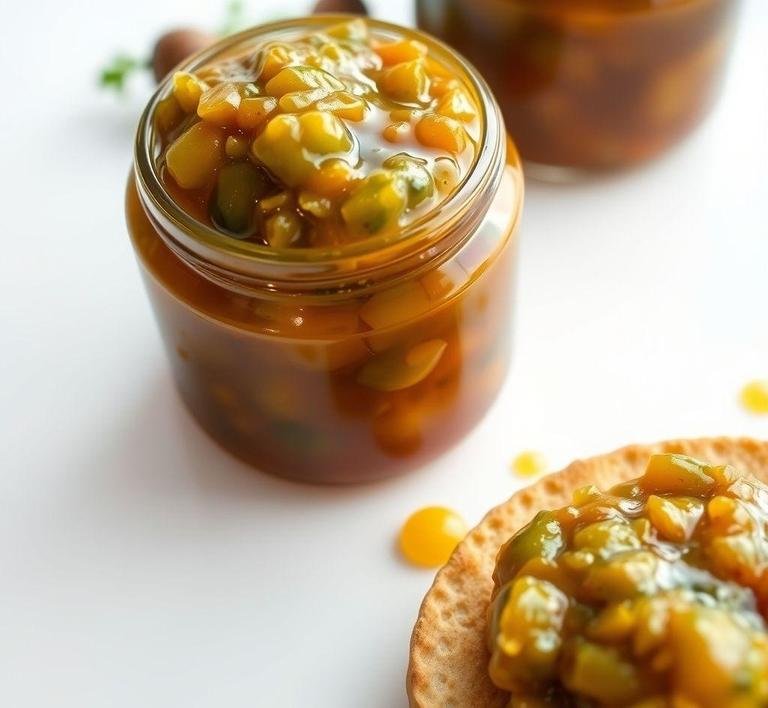The first time I made Nigella’s gooseberry chutney, it was the start of June and I’d just come back from a farm shop with two big paper bags of green gooseberries. the kind that look like little translucent emeralds with tiny fuzz on their skin. My fingers were stained from topping and tailing them and I remember thinking how much they reminded me of my grandmother’s garden in Yorkshire, where the bushes practically groaned with tart little globes.
Nigella Lawson’s version of gooseberry chutney is a glorious tribute to the fruit’s assertively sour personality. softened but not tamed. This isn’t a background chutney. It doesn’t whisper politely from the side of a cheeseboard. It sings. Loudly. With vinegar and sugar and ginger and allspice in its choir.
It’s the kind of thing you make in a big old pot on a lazy Sunday, when the house smells like spiced vinegar and you know that you’re making something that will age like wine in its jar. ready to be slathered on a cold pork sandwich or spooned next to a slice of sharp cheddar when the rain taps on the window.
Nigella Gooseberry Chutney Recipe
Ingredients Needed

Here’s what you’ll need. No substitutions today – let’s make it just the way Nigella intended.
- 1 kg gooseberries, topped and tailed
- 2 medium onions, finely chopped
- 500g light brown sugar
- 1 tsp ground ginger
- 1 tsp ground allspice
- ½ tsp ground cloves
- 1 tsp salt
- 500ml cider vinegar
Now, I’ll be honest. the first time I made this, I tried to use malt vinegar because it was all I had. Don’t. The delicate tang of cider vinegar is crucial. It lifts the whole thing and doesn’t bully the berries.
Equipment Needed
When it comes to making chutney, your setup can really make or break the process. Here’s what I keep close:
- A large heavy-bottomed saucepan or preserving pan (avoid anything too thin. the sugar can catch and burn)
- A good old-fashioned wooden spoon (trust me, plastic ones start to smell of vinegar)
- A chopping board and sharp knife
- A measuring jug and scales
- Several sterilized glass jars with tight-fitting lids
- A funnel (unless you enjoy sticky hands and chaos)
I sterilize my jars the way my mother taught me. boiling water or a run through the dishwasher, then into the oven at a low temp to dry. It’s part of the ritual, like setting the scene for a small, vinegary performance.
Instructions To Make Nigella Lawson’s Gooseberry Chutney
-
Prep the gooseberries.
This is meditative, honestly. Sitting by the kitchen table with a bowl in your lap, snipping off the tops and tails with small scissors or a paring knife. It’s not fast but it’s grounding. Like shelling peas or shucking corn.
-
Into the pot they go.
Dump the gooseberries into your preserving pan. Add the chopped onions, sugar, vinegar and spices. It won’t look pretty at this stage. sort of like a cauldron of confused fruit salad.
-
Bring it to a gentle boil.
Stir often. The sugar needs to dissolve completely before anything starts thickening. I remember this part vividly: the kitchen filled with the sweet-and-sour fog of vinegar and sugar melding with the fruit, the kind of smell that makes your nose wrinkle and your stomach growl all at once.
-
Simmer for about 1-1.5 hours.
Keep it low and slow. Stir now and then to keep it from sticking. You’re looking for a thick, glossy mixture. it should look more like a chutney and less like a fruit soup.
-
Bottle it up.
While still hot, ladle the chutney into sterilized jars. Seal them immediately. I always label them with the date and a scribbled note. ’Sharp and spicy gooseberry chutney. DO NOT EAT YET!’
What I Learnt
Making gooseberry chutney taught me that good things really do take time. not just in the cooking but in the waiting.
You see, this chutney is a diva. It needs to rest. Three weeks at the very least but honestly? Try not to open it for a couple of months. When you first taste it, the vinegar might still bite but give it time and it mellows into something complex, something you’d swear took more than just a few ingredients and a saucepan.
I also learnt that preserving is as much about preserving moments as it is about food. When I opened my first jar that autumn, I remembered the gooseberries in my hand, the sunlight coming through the window, the cat weaving around my ankles as the pot simmered. The chutney kept that moment for me.
FAQs
Can I Substitute Gooseberries With Another Fruit In Nigella Lawson’s Chutney Recipe?
You could, but it won’t be quite the same! Gooseberries give that tart, slightly sour edge which is key to the flavor profile. If you’re feeling adventurous, green apples could be an interesting substitute, though the result might be a little less tangy.
How Long Does Nigella’s Gooseberry Chutney Last?
Once it’s cooled, you can store it in sterilized jars and it’ll last for about 6 months in a cool, dark place. Once opened, keep it in the fridge and use it within a month or so. But honestly, it never lasts that long-it’s too good!
Can I Make Nigella’s Gooseberry Chutney Spicier?
Absolutely! If you love a bit of heat, you can increase the amount of chili or add some fresh ginger. Just be cautious-go slowly and taste as you go, since the spices will deepen as the chutney sits.


